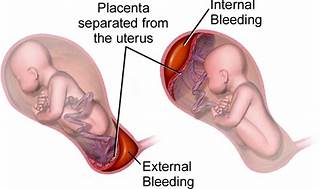A nurse is reinforcing teaching with a client who is at 34 weeks of gestation and at risk for placental abruption. Does the nurse recognize that which of the following is the most common risk factor for a placental abruption?
Maternal hypertension.
Maternal cocaine use.
Maternal cigarette smoking.
Maternal battering.
The Correct Answer is A

The correct answer is choice A, Maternal hypertension.
Choice A rationale:
Maternal hypertension is widely recognized as the most common risk factor for placental abruption. High blood pressure can cause the placenta to detach from the uterine wall, leading to abruption. In summary, while all the listed factors can contribute to the risk of placental abruption, maternal hypertension stands out as the most common cause, supported by multiple health sources. It’s important for nurses to recognize and manage hypertension in pregnant clients to minimize the risk of this serious complication.
Choice B rationale:
While maternal cocaine use is a significant risk factor for placental abruption due to its vasoconstrictive effects, which can compromise the placental blood flow, it is not as common as maternal hypertension.
Choice C rationale:
Maternal cigarette smoking is also a risk factor for placental abruption. Smoking can lead to a variety of complications in pregnancy, including placental problems, but again, it is less common than hypertension as a cause for abruption.
Choice D rationale:
Maternal battering can lead to trauma which may result in placental abruption. However, it is not considered the most common risk factor when compared to maternal hypertension.
Nursing Test Bank
Naxlex Comprehensive Predictor Exams
Related Questions
Correct Answer is ["6"]
Explanation
The Apgar s core is a s coring s ys tem doctors and nurs es us e to as s es s newborns after they’re born. The Apgar s coring s ys tem is divided into five categories : Activity, Puls e, Grimace, Appearance, and Res piration. Each category receives a s core of 0 to 2 points 1.
Bas ed on the information you provided, the newborn’s 1-min Apgar s core would be calculated as follows :
• Activity: s ome flexion of extremities = 1 point
• Puls e: heart rate 110/ min = 2 points
• Grimace: grimace in res pons e to s uctioning of the nares = 1 point
• Appearance: body pink in color with blue extremities = 1 point
• Res piration: s low, weak cry = 1 point
Adding up the points for each category, the newborn’s 1-min Apgar s core would be 6.
Correct Answer is C
Explanation
Choice A rationale:
A fetal heart rate of 100/min for a 10-minute period is considered within the normal range. The normal fetal heart rate can range from 110 to 160 beats per minute, and a rate of 100 is not concerning.
Choice B rationale:
The resting period of a contraction refers to the time between contractions when the uterus is relaxed. A resting period of 35 seconds is also considered normal. In labor, the resting period between contractions allows the placenta to receive oxygen and nutrients, and 35 seconds is a rationaleable duration.
Choice C rationale:
A contraction lasting 85 seconds is abnormal and should be reported to the provider. Normally, contractions last around 60-90 seconds, but an 85-second contraction may indicate uterine hyperactivity or other issues that could potentially affect the well-being of both the mother and the baby.
Choice D rationale:
Having four contractions in a 10-minute period is considered normal during labor. In fact, an average pattern includes 3-5 contractions within a 10-minute window, so this finding is not a cause for concern.
Whether you are a student looking to ace your exams or a practicing nurse seeking to enhance your expertise , our nursing education contents will empower you with the confidence and competence to make a difference in the lives of patients and become a respected leader in the healthcare field.
Visit Naxlex, invest in your future and unlock endless possibilities with our unparalleled nursing education contents today
Report Wrong Answer on the Current Question
Do you disagree with the answer? If yes, what is your expected answer? Explain.
Kindly be descriptive with the issue you are facing.
